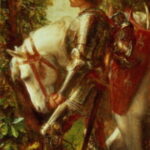The movies, and the books before them, offer some myths about the knight of olde that are actually pretty odd. But it is understandable, if you realize the writers made certain unwarranted linked assumptions about the knights, assumptions that led to lingering cliches because they didn’t understand the basic fact that set the cliche’s in motion.
The movies often show to comedic effect a lumbering, armor-clad oaf who can’t see what he’s doing and can easily be tripped up, needs a block-and-tackle to mount his horse, and has the elegance of a train.
Forget it. These guys were trained warriors and killers. They were not about to leave themselves vulnerable to attack by living out a movie cliche.
WHO IS THE KNIGHT?
The knight generally began as a fairly well-to-do guy with money that allowed him to devote time to train for war. As a knight, he became a landowner with his own “fief”, owing allegiance (“fealty”) to a greater landowner (the local nobility) who, in turn, owed allegiance to the king. Taxes collected from serfs and peasants supported him. As landlord, he could also levy foot soldiers and archers from among his tenants.
When called up for duty, he had to be ready. He had a staff of helpers, knights-in-training called squires. These cost money as did his trained warhorse, his most formidable weapon with its weight, trained responses, and flailing hooves.
Obviously, this all cost money, hence his likely well-born, although not always wealthy, origins. Actually, a would-be knight could work his way in to the ranks. One way would be to capture a knight, claim his armor as spoils of war, and hold the enemy knight for ransom, which was a typical weay of dealing with armored POW’s.
PROTECTED BY ARMOR
Early Medieval knights were protected by heavy but fairly effective chainmail as their Roman predecessors had been so protected.
Chainmail would soon give way to the knight’s familiar armor, or “harness”, would develop, protecting him from arrows, even bullets from the early handguns encountered late in the period. What the knight was especially vulnerable to was a pounding type of weapon, delivering concussive force that could cause broken bones. At the least, the pounding would produce dents in the armor that would begin limiting its flexibility, increasing the knight’s vulnerability.
As for maneuverability, the movies assume that the knight’s armor was incredibly heavy, hence the block-and-tackle to get him in the saddle. A critic of the movie Excalibur remarked on the ridiculously light horses that the impressively armored armored knights rode.
Actually, the armor our knight wore, with helmet, amounted to about 70 pounds. That has, in fact, typically been the average weight of armor and weapons from ancient times to modern. This is where the string of mistaken assumptions begins.
Like his fellow warriors throughout history, a physically capable knight adjusted to the armor’s weight by developing the muscles required through practice.
The armor was donned in segments, with riveting that allowed for the parts to move while staying strongly linked. The primary purpose was to permit a sword strike to be deflected so the blade slid off.
The armor as assembled allowed the knight plenty of flexibility in combat. I’ve seen (in person, not on TV) a guy in modern armor based on old designs who showed himself very capable of fluid movement.
Remember that Three Stooges short with the knight doing a dance in armor, slapping his knees at the end? That’s the kind of flexibility we’re talking about.
The knight’s seat was left unarmored so he could ride his horse. A chainmail skirt helped protect that area as well as the front. The bottom of his armored feet were left exposed so he could have direct contact with the stirrups.
A COUPLE QUICK CLICHES
When it came time to mount his horse, the knight easily mounted mount from a box, or in the field, from a rock or with the help of a squire offering a cupped-hand assist. Nothing more.
Similarly, the suggestions that a knight fallen on to his back could not get up on his own is similarly mistaken. Remember, his life depends on this.
His helmet protected his head but despite some limitations on his vision, he was able to function.
FINALLY…
The knight was successful, especially since all of feudal Europe operated in the same way. In fact, the biggest challenge to this formidable system was the attack by Genghis Khan and his progeny on Europe, leading an army of unarmored, poney-mounted, swift-moving archers with powerful recurve bows, operating, unlike most knights, as a highly coordinated team.




